IHRM Strategies and Challenges: A Case Study of 'No Name' Aircraft
VerifiedAdded on 2023/06/14
|11
|3326
|148
Case Study
AI Summary
This case study delves into the HRM challenges faced by 'No Name' Aircraft, focusing on issues within organizational culture, diversity management, international performance management, and training and development. The analysis reveals communication breakdowns, negative cultural norms, intolerance towards generational diversity, lack of recruitment of individuals with disabilities, absence of international appraisals, and inadequate expatriate training programs. To address these challenges, the study suggests implementing strategies such as fostering high-performance organizational cultures, utilizing HRM toolkits to address inequalities, embracing consultant approaches to increase productivity through diversity, and recognizing the importance of formal performance appraisal practices. The case study emphasizes the need for strategic thinking, effective communication, and individual-centered policies to enhance the overall effectiveness and harmony within the organization. Desklib provides access to similar case studies and solved assignments for students seeking further assistance.
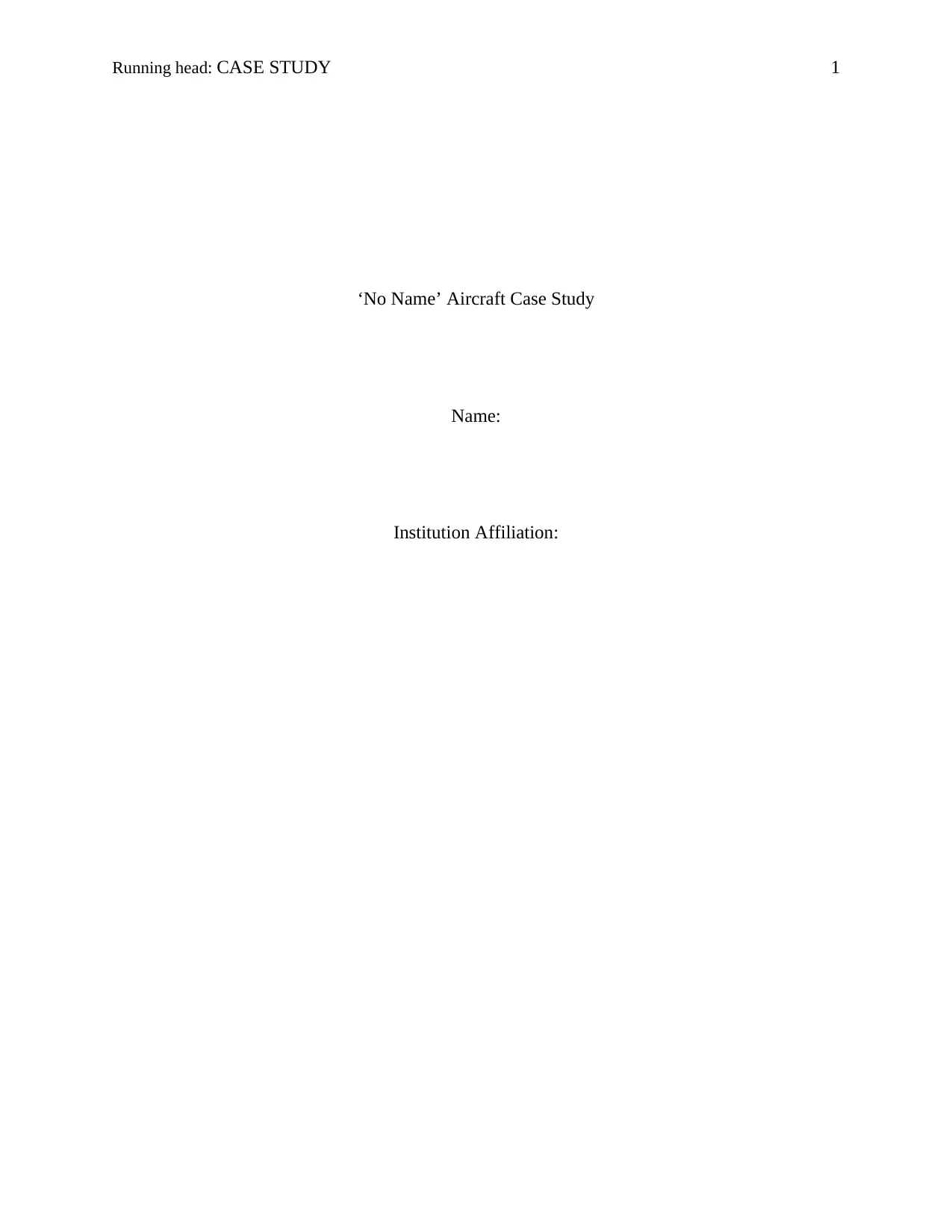
Running head: CASE STUDY 1
‘No Name’ Aircraft Case Study
Name:
Institution Affiliation:
‘No Name’ Aircraft Case Study
Name:
Institution Affiliation:
Paraphrase This Document
Need a fresh take? Get an instant paraphrase of this document with our AI Paraphraser
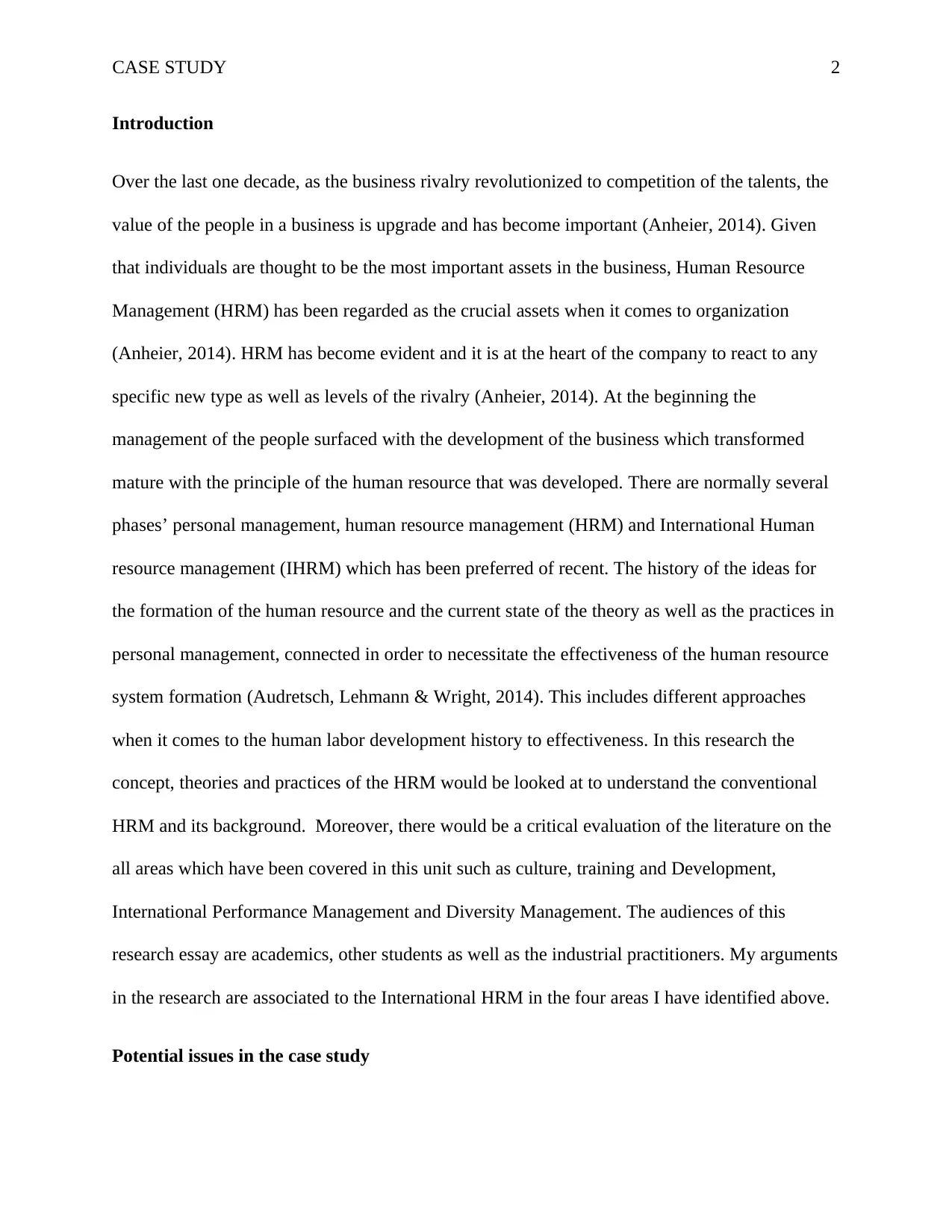
CASE STUDY 2
Introduction
Over the last one decade, as the business rivalry revolutionized to competition of the talents, the
value of the people in a business is upgrade and has become important (Anheier, 2014). Given
that individuals are thought to be the most important assets in the business, Human Resource
Management (HRM) has been regarded as the crucial assets when it comes to organization
(Anheier, 2014). HRM has become evident and it is at the heart of the company to react to any
specific new type as well as levels of the rivalry (Anheier, 2014). At the beginning the
management of the people surfaced with the development of the business which transformed
mature with the principle of the human resource that was developed. There are normally several
phases’ personal management, human resource management (HRM) and International Human
resource management (IHRM) which has been preferred of recent. The history of the ideas for
the formation of the human resource and the current state of the theory as well as the practices in
personal management, connected in order to necessitate the effectiveness of the human resource
system formation (Audretsch, Lehmann & Wright, 2014). This includes different approaches
when it comes to the human labor development history to effectiveness. In this research the
concept, theories and practices of the HRM would be looked at to understand the conventional
HRM and its background. Moreover, there would be a critical evaluation of the literature on the
all areas which have been covered in this unit such as culture, training and Development,
International Performance Management and Diversity Management. The audiences of this
research essay are academics, other students as well as the industrial practitioners. My arguments
in the research are associated to the International HRM in the four areas I have identified above.
Potential issues in the case study
Introduction
Over the last one decade, as the business rivalry revolutionized to competition of the talents, the
value of the people in a business is upgrade and has become important (Anheier, 2014). Given
that individuals are thought to be the most important assets in the business, Human Resource
Management (HRM) has been regarded as the crucial assets when it comes to organization
(Anheier, 2014). HRM has become evident and it is at the heart of the company to react to any
specific new type as well as levels of the rivalry (Anheier, 2014). At the beginning the
management of the people surfaced with the development of the business which transformed
mature with the principle of the human resource that was developed. There are normally several
phases’ personal management, human resource management (HRM) and International Human
resource management (IHRM) which has been preferred of recent. The history of the ideas for
the formation of the human resource and the current state of the theory as well as the practices in
personal management, connected in order to necessitate the effectiveness of the human resource
system formation (Audretsch, Lehmann & Wright, 2014). This includes different approaches
when it comes to the human labor development history to effectiveness. In this research the
concept, theories and practices of the HRM would be looked at to understand the conventional
HRM and its background. Moreover, there would be a critical evaluation of the literature on the
all areas which have been covered in this unit such as culture, training and Development,
International Performance Management and Diversity Management. The audiences of this
research essay are academics, other students as well as the industrial practitioners. My arguments
in the research are associated to the International HRM in the four areas I have identified above.
Potential issues in the case study
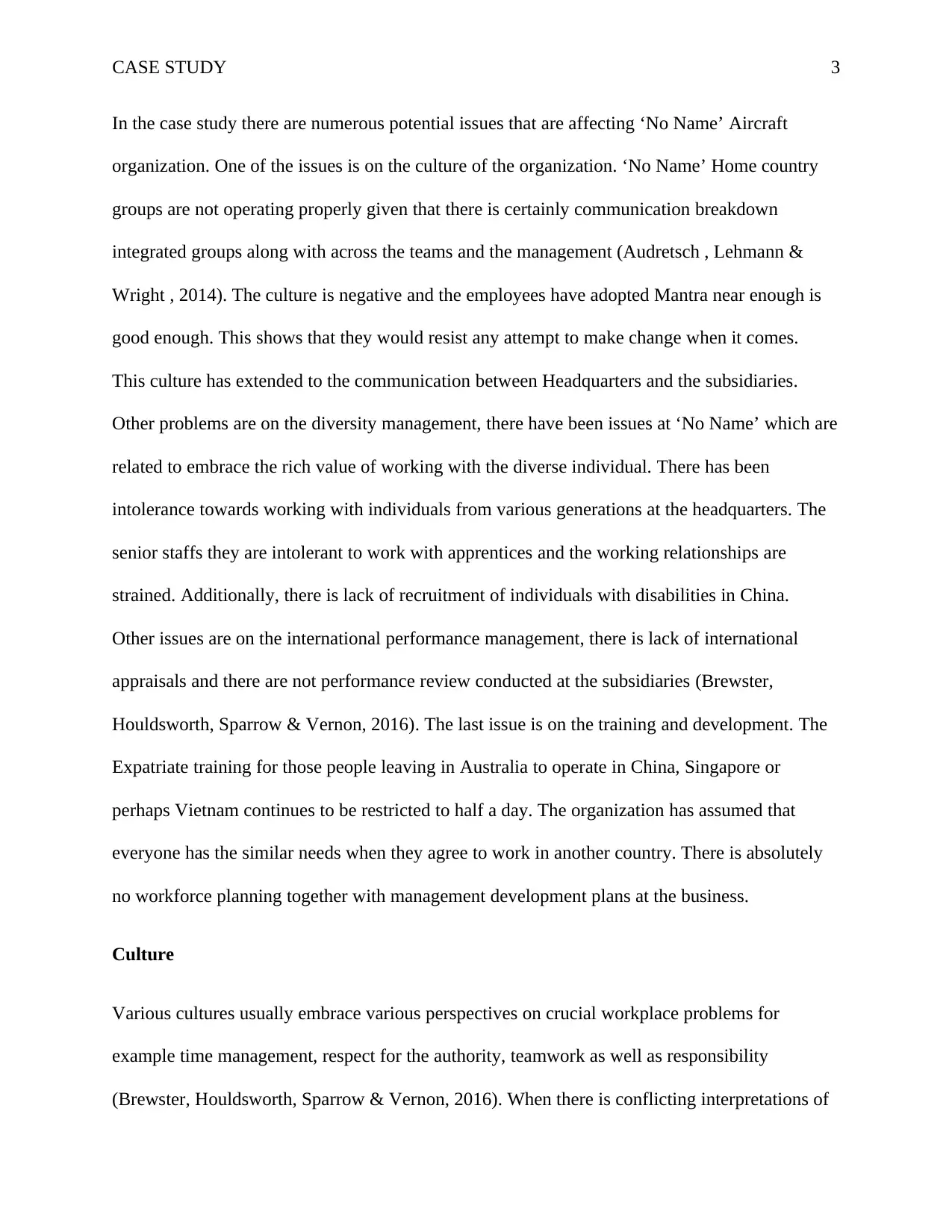
CASE STUDY 3
In the case study there are numerous potential issues that are affecting ‘No Name’ Aircraft
organization. One of the issues is on the culture of the organization. ‘No Name’ Home country
groups are not operating properly given that there is certainly communication breakdown
integrated groups along with across the teams and the management (Audretsch , Lehmann &
Wright , 2014). The culture is negative and the employees have adopted Mantra near enough is
good enough. This shows that they would resist any attempt to make change when it comes.
This culture has extended to the communication between Headquarters and the subsidiaries.
Other problems are on the diversity management, there have been issues at ‘No Name’ which are
related to embrace the rich value of working with the diverse individual. There has been
intolerance towards working with individuals from various generations at the headquarters. The
senior staffs they are intolerant to work with apprentices and the working relationships are
strained. Additionally, there is lack of recruitment of individuals with disabilities in China.
Other issues are on the international performance management, there is lack of international
appraisals and there are not performance review conducted at the subsidiaries (Brewster,
Houldsworth, Sparrow & Vernon, 2016). The last issue is on the training and development. The
Expatriate training for those people leaving in Australia to operate in China, Singapore or
perhaps Vietnam continues to be restricted to half a day. The organization has assumed that
everyone has the similar needs when they agree to work in another country. There is absolutely
no workforce planning together with management development plans at the business.
Culture
Various cultures usually embrace various perspectives on crucial workplace problems for
example time management, respect for the authority, teamwork as well as responsibility
(Brewster, Houldsworth, Sparrow & Vernon, 2016). When there is conflicting interpretations of
In the case study there are numerous potential issues that are affecting ‘No Name’ Aircraft
organization. One of the issues is on the culture of the organization. ‘No Name’ Home country
groups are not operating properly given that there is certainly communication breakdown
integrated groups along with across the teams and the management (Audretsch , Lehmann &
Wright , 2014). The culture is negative and the employees have adopted Mantra near enough is
good enough. This shows that they would resist any attempt to make change when it comes.
This culture has extended to the communication between Headquarters and the subsidiaries.
Other problems are on the diversity management, there have been issues at ‘No Name’ which are
related to embrace the rich value of working with the diverse individual. There has been
intolerance towards working with individuals from various generations at the headquarters. The
senior staffs they are intolerant to work with apprentices and the working relationships are
strained. Additionally, there is lack of recruitment of individuals with disabilities in China.
Other issues are on the international performance management, there is lack of international
appraisals and there are not performance review conducted at the subsidiaries (Brewster,
Houldsworth, Sparrow & Vernon, 2016). The last issue is on the training and development. The
Expatriate training for those people leaving in Australia to operate in China, Singapore or
perhaps Vietnam continues to be restricted to half a day. The organization has assumed that
everyone has the similar needs when they agree to work in another country. There is absolutely
no workforce planning together with management development plans at the business.
Culture
Various cultures usually embrace various perspectives on crucial workplace problems for
example time management, respect for the authority, teamwork as well as responsibility
(Brewster, Houldsworth, Sparrow & Vernon, 2016). When there is conflicting interpretations of
⊘ This is a preview!⊘
Do you want full access?
Subscribe today to unlock all pages.

Trusted by 1+ million students worldwide
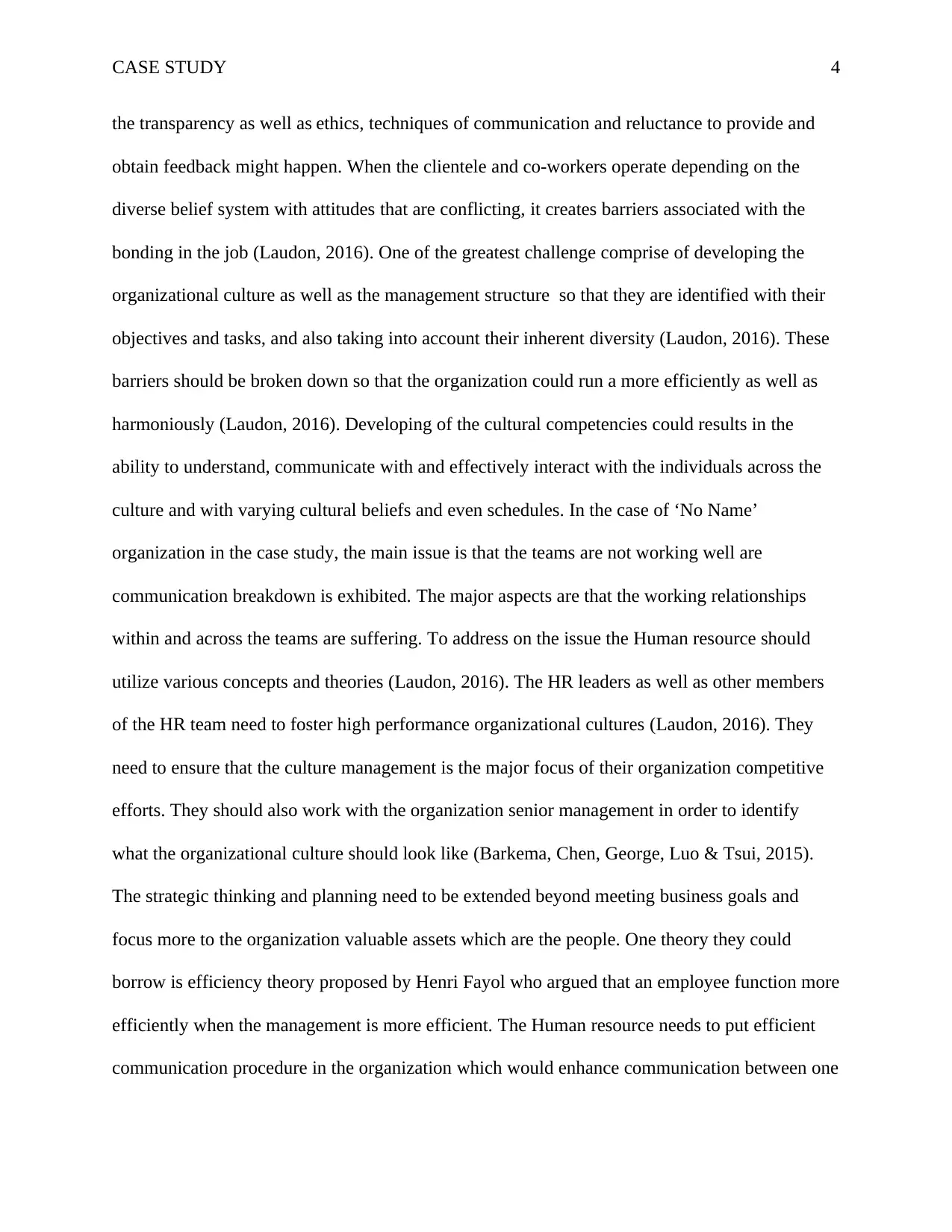
CASE STUDY 4
the transparency as well as ethics, techniques of communication and reluctance to provide and
obtain feedback might happen. When the clientele and co-workers operate depending on the
diverse belief system with attitudes that are conflicting, it creates barriers associated with the
bonding in the job (Laudon, 2016). One of the greatest challenge comprise of developing the
organizational culture as well as the management structure so that they are identified with their
objectives and tasks, and also taking into account their inherent diversity (Laudon, 2016). These
barriers should be broken down so that the organization could run a more efficiently as well as
harmoniously (Laudon, 2016). Developing of the cultural competencies could results in the
ability to understand, communicate with and effectively interact with the individuals across the
culture and with varying cultural beliefs and even schedules. In the case of ‘No Name’
organization in the case study, the main issue is that the teams are not working well are
communication breakdown is exhibited. The major aspects are that the working relationships
within and across the teams are suffering. To address on the issue the Human resource should
utilize various concepts and theories (Laudon, 2016). The HR leaders as well as other members
of the HR team need to foster high performance organizational cultures (Laudon, 2016). They
need to ensure that the culture management is the major focus of their organization competitive
efforts. They should also work with the organization senior management in order to identify
what the organizational culture should look like (Barkema, Chen, George, Luo & Tsui, 2015).
The strategic thinking and planning need to be extended beyond meeting business goals and
focus more to the organization valuable assets which are the people. One theory they could
borrow is efficiency theory proposed by Henri Fayol who argued that an employee function more
efficiently when the management is more efficient. The Human resource needs to put efficient
communication procedure in the organization which would enhance communication between one
the transparency as well as ethics, techniques of communication and reluctance to provide and
obtain feedback might happen. When the clientele and co-workers operate depending on the
diverse belief system with attitudes that are conflicting, it creates barriers associated with the
bonding in the job (Laudon, 2016). One of the greatest challenge comprise of developing the
organizational culture as well as the management structure so that they are identified with their
objectives and tasks, and also taking into account their inherent diversity (Laudon, 2016). These
barriers should be broken down so that the organization could run a more efficiently as well as
harmoniously (Laudon, 2016). Developing of the cultural competencies could results in the
ability to understand, communicate with and effectively interact with the individuals across the
culture and with varying cultural beliefs and even schedules. In the case of ‘No Name’
organization in the case study, the main issue is that the teams are not working well are
communication breakdown is exhibited. The major aspects are that the working relationships
within and across the teams are suffering. To address on the issue the Human resource should
utilize various concepts and theories (Laudon, 2016). The HR leaders as well as other members
of the HR team need to foster high performance organizational cultures (Laudon, 2016). They
need to ensure that the culture management is the major focus of their organization competitive
efforts. They should also work with the organization senior management in order to identify
what the organizational culture should look like (Barkema, Chen, George, Luo & Tsui, 2015).
The strategic thinking and planning need to be extended beyond meeting business goals and
focus more to the organization valuable assets which are the people. One theory they could
borrow is efficiency theory proposed by Henri Fayol who argued that an employee function more
efficiently when the management is more efficient. The Human resource needs to put efficient
communication procedure in the organization which would enhance communication between one
Paraphrase This Document
Need a fresh take? Get an instant paraphrase of this document with our AI Paraphraser
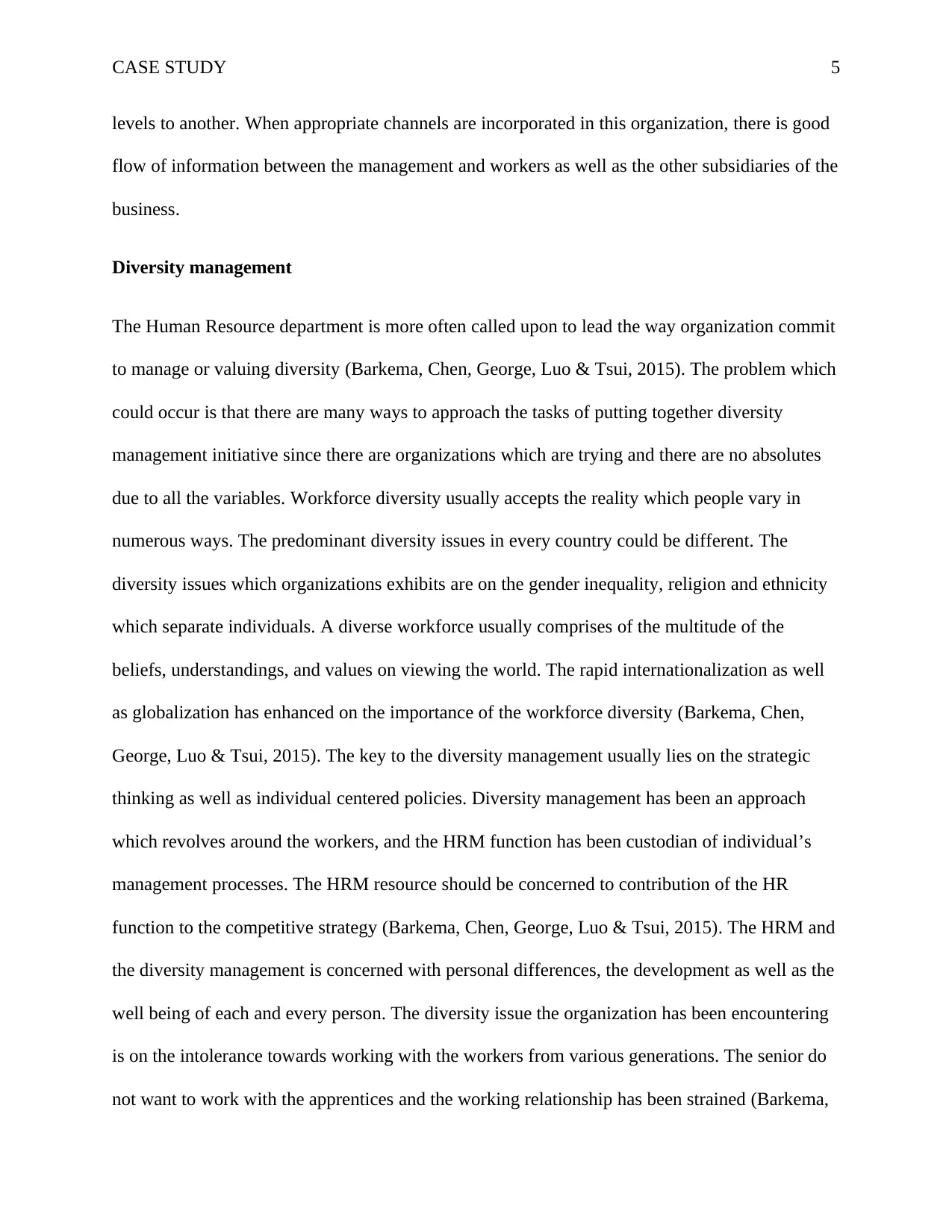
CASE STUDY 5
levels to another. When appropriate channels are incorporated in this organization, there is good
flow of information between the management and workers as well as the other subsidiaries of the
business.
Diversity management
The Human Resource department is more often called upon to lead the way organization commit
to manage or valuing diversity (Barkema, Chen, George, Luo & Tsui, 2015). The problem which
could occur is that there are many ways to approach the tasks of putting together diversity
management initiative since there are organizations which are trying and there are no absolutes
due to all the variables. Workforce diversity usually accepts the reality which people vary in
numerous ways. The predominant diversity issues in every country could be different. The
diversity issues which organizations exhibits are on the gender inequality, religion and ethnicity
which separate individuals. A diverse workforce usually comprises of the multitude of the
beliefs, understandings, and values on viewing the world. The rapid internationalization as well
as globalization has enhanced on the importance of the workforce diversity (Barkema, Chen,
George, Luo & Tsui, 2015). The key to the diversity management usually lies on the strategic
thinking as well as individual centered policies. Diversity management has been an approach
which revolves around the workers, and the HRM function has been custodian of individual’s
management processes. The HRM resource should be concerned to contribution of the HR
function to the competitive strategy (Barkema, Chen, George, Luo & Tsui, 2015). The HRM and
the diversity management is concerned with personal differences, the development as well as the
well being of each and every person. The diversity issue the organization has been encountering
is on the intolerance towards working with the workers from various generations. The senior do
not want to work with the apprentices and the working relationship has been strained (Barkema,
levels to another. When appropriate channels are incorporated in this organization, there is good
flow of information between the management and workers as well as the other subsidiaries of the
business.
Diversity management
The Human Resource department is more often called upon to lead the way organization commit
to manage or valuing diversity (Barkema, Chen, George, Luo & Tsui, 2015). The problem which
could occur is that there are many ways to approach the tasks of putting together diversity
management initiative since there are organizations which are trying and there are no absolutes
due to all the variables. Workforce diversity usually accepts the reality which people vary in
numerous ways. The predominant diversity issues in every country could be different. The
diversity issues which organizations exhibits are on the gender inequality, religion and ethnicity
which separate individuals. A diverse workforce usually comprises of the multitude of the
beliefs, understandings, and values on viewing the world. The rapid internationalization as well
as globalization has enhanced on the importance of the workforce diversity (Barkema, Chen,
George, Luo & Tsui, 2015). The key to the diversity management usually lies on the strategic
thinking as well as individual centered policies. Diversity management has been an approach
which revolves around the workers, and the HRM function has been custodian of individual’s
management processes. The HRM resource should be concerned to contribution of the HR
function to the competitive strategy (Barkema, Chen, George, Luo & Tsui, 2015). The HRM and
the diversity management is concerned with personal differences, the development as well as the
well being of each and every person. The diversity issue the organization has been encountering
is on the intolerance towards working with the workers from various generations. The senior do
not want to work with the apprentices and the working relationship has been strained (Barkema,
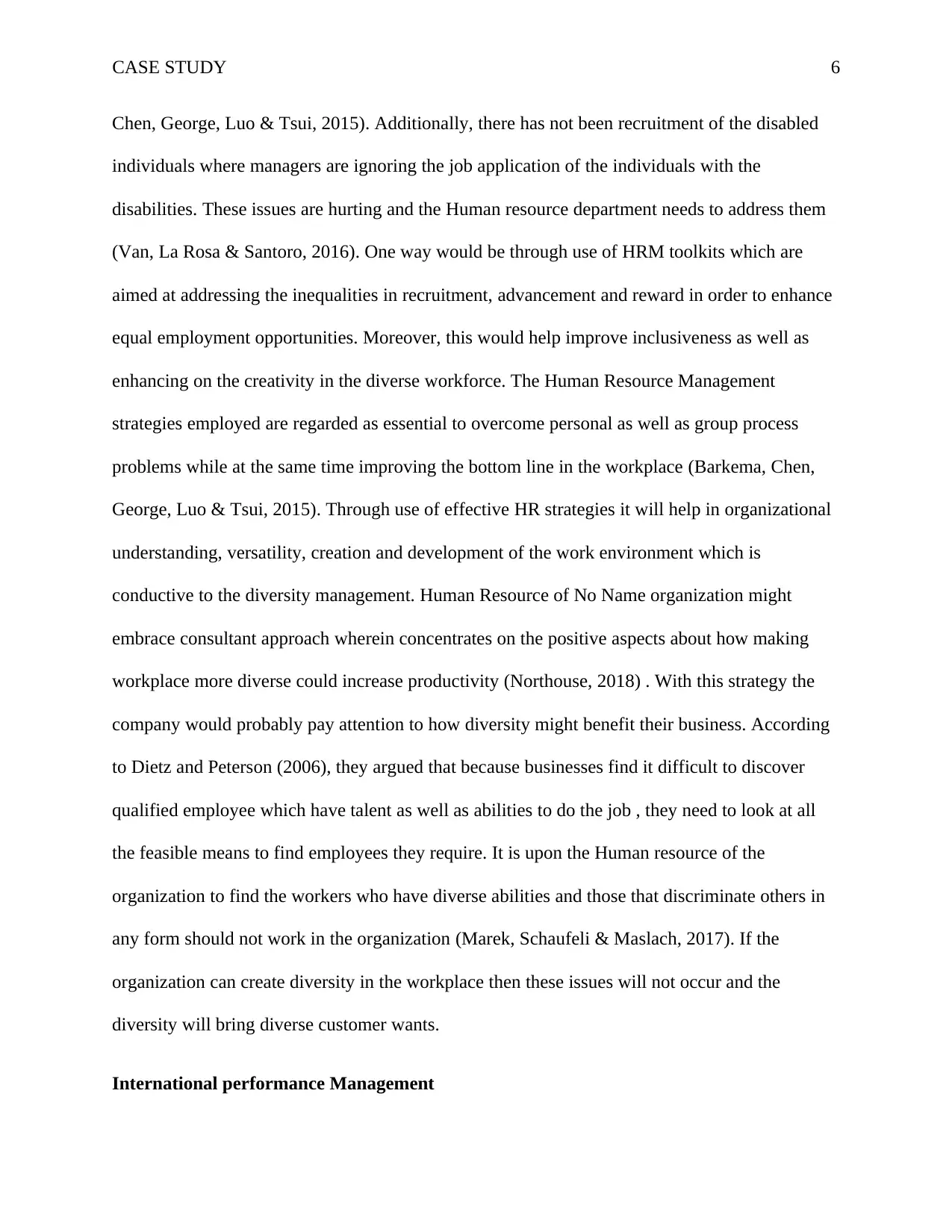
CASE STUDY 6
Chen, George, Luo & Tsui, 2015). Additionally, there has not been recruitment of the disabled
individuals where managers are ignoring the job application of the individuals with the
disabilities. These issues are hurting and the Human resource department needs to address them
(Van, La Rosa & Santoro, 2016). One way would be through use of HRM toolkits which are
aimed at addressing the inequalities in recruitment, advancement and reward in order to enhance
equal employment opportunities. Moreover, this would help improve inclusiveness as well as
enhancing on the creativity in the diverse workforce. The Human Resource Management
strategies employed are regarded as essential to overcome personal as well as group process
problems while at the same time improving the bottom line in the workplace (Barkema, Chen,
George, Luo & Tsui, 2015). Through use of effective HR strategies it will help in organizational
understanding, versatility, creation and development of the work environment which is
conductive to the diversity management. Human Resource of No Name organization might
embrace consultant approach wherein concentrates on the positive aspects about how making
workplace more diverse could increase productivity (Northouse, 2018) . With this strategy the
company would probably pay attention to how diversity might benefit their business. According
to Dietz and Peterson (2006), they argued that because businesses find it difficult to discover
qualified employee which have talent as well as abilities to do the job , they need to look at all
the feasible means to find employees they require. It is upon the Human resource of the
organization to find the workers who have diverse abilities and those that discriminate others in
any form should not work in the organization (Marek, Schaufeli & Maslach, 2017). If the
organization can create diversity in the workplace then these issues will not occur and the
diversity will bring diverse customer wants.
International performance Management
Chen, George, Luo & Tsui, 2015). Additionally, there has not been recruitment of the disabled
individuals where managers are ignoring the job application of the individuals with the
disabilities. These issues are hurting and the Human resource department needs to address them
(Van, La Rosa & Santoro, 2016). One way would be through use of HRM toolkits which are
aimed at addressing the inequalities in recruitment, advancement and reward in order to enhance
equal employment opportunities. Moreover, this would help improve inclusiveness as well as
enhancing on the creativity in the diverse workforce. The Human Resource Management
strategies employed are regarded as essential to overcome personal as well as group process
problems while at the same time improving the bottom line in the workplace (Barkema, Chen,
George, Luo & Tsui, 2015). Through use of effective HR strategies it will help in organizational
understanding, versatility, creation and development of the work environment which is
conductive to the diversity management. Human Resource of No Name organization might
embrace consultant approach wherein concentrates on the positive aspects about how making
workplace more diverse could increase productivity (Northouse, 2018) . With this strategy the
company would probably pay attention to how diversity might benefit their business. According
to Dietz and Peterson (2006), they argued that because businesses find it difficult to discover
qualified employee which have talent as well as abilities to do the job , they need to look at all
the feasible means to find employees they require. It is upon the Human resource of the
organization to find the workers who have diverse abilities and those that discriminate others in
any form should not work in the organization (Marek, Schaufeli & Maslach, 2017). If the
organization can create diversity in the workplace then these issues will not occur and the
diversity will bring diverse customer wants.
International performance Management
⊘ This is a preview!⊘
Do you want full access?
Subscribe today to unlock all pages.

Trusted by 1+ million students worldwide
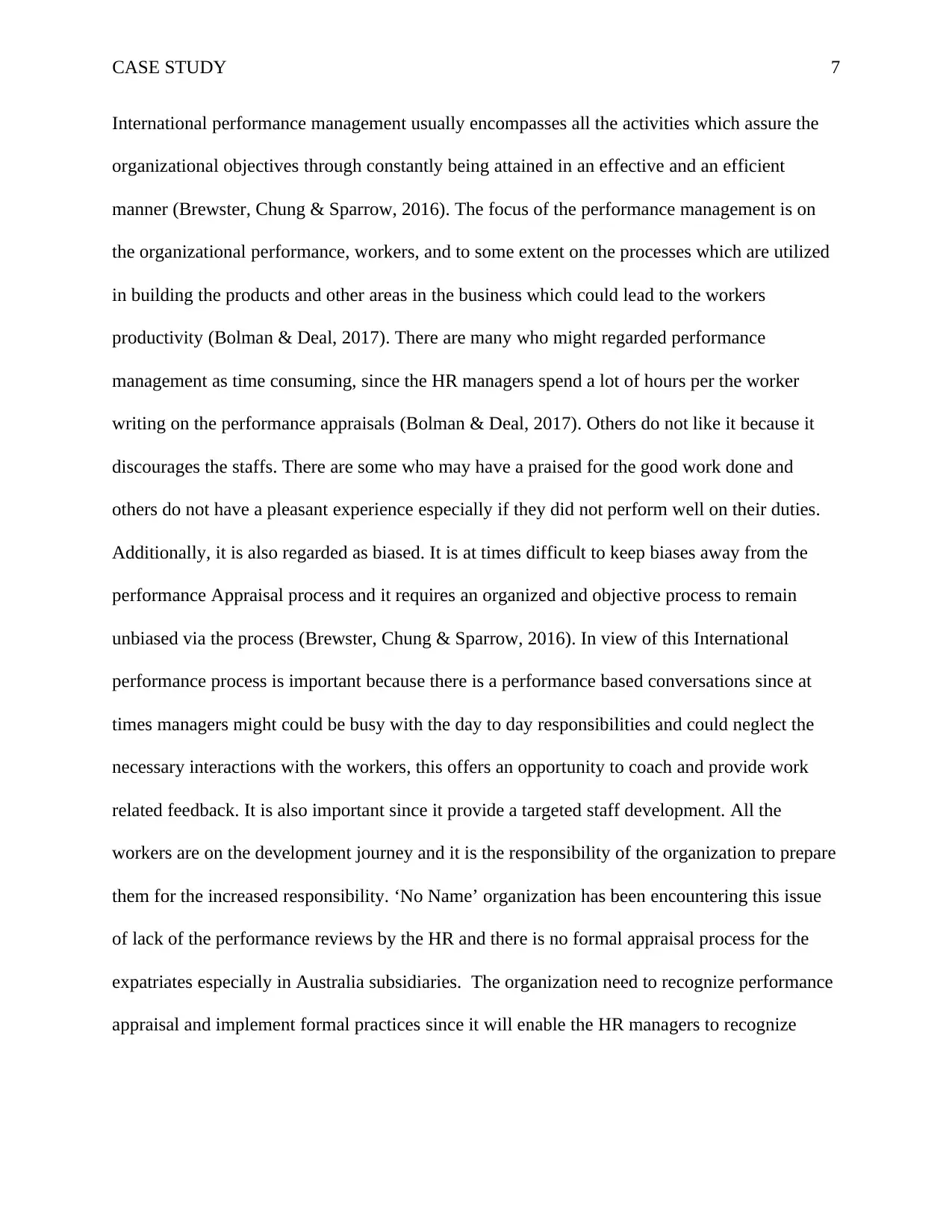
CASE STUDY 7
International performance management usually encompasses all the activities which assure the
organizational objectives through constantly being attained in an effective and an efficient
manner (Brewster, Chung & Sparrow, 2016). The focus of the performance management is on
the organizational performance, workers, and to some extent on the processes which are utilized
in building the products and other areas in the business which could lead to the workers
productivity (Bolman & Deal, 2017). There are many who might regarded performance
management as time consuming, since the HR managers spend a lot of hours per the worker
writing on the performance appraisals (Bolman & Deal, 2017). Others do not like it because it
discourages the staffs. There are some who may have a praised for the good work done and
others do not have a pleasant experience especially if they did not perform well on their duties.
Additionally, it is also regarded as biased. It is at times difficult to keep biases away from the
performance Appraisal process and it requires an organized and objective process to remain
unbiased via the process (Brewster, Chung & Sparrow, 2016). In view of this International
performance process is important because there is a performance based conversations since at
times managers might could be busy with the day to day responsibilities and could neglect the
necessary interactions with the workers, this offers an opportunity to coach and provide work
related feedback. It is also important since it provide a targeted staff development. All the
workers are on the development journey and it is the responsibility of the organization to prepare
them for the increased responsibility. ‘No Name’ organization has been encountering this issue
of lack of the performance reviews by the HR and there is no formal appraisal process for the
expatriates especially in Australia subsidiaries. The organization need to recognize performance
appraisal and implement formal practices since it will enable the HR managers to recognize
International performance management usually encompasses all the activities which assure the
organizational objectives through constantly being attained in an effective and an efficient
manner (Brewster, Chung & Sparrow, 2016). The focus of the performance management is on
the organizational performance, workers, and to some extent on the processes which are utilized
in building the products and other areas in the business which could lead to the workers
productivity (Bolman & Deal, 2017). There are many who might regarded performance
management as time consuming, since the HR managers spend a lot of hours per the worker
writing on the performance appraisals (Bolman & Deal, 2017). Others do not like it because it
discourages the staffs. There are some who may have a praised for the good work done and
others do not have a pleasant experience especially if they did not perform well on their duties.
Additionally, it is also regarded as biased. It is at times difficult to keep biases away from the
performance Appraisal process and it requires an organized and objective process to remain
unbiased via the process (Brewster, Chung & Sparrow, 2016). In view of this International
performance process is important because there is a performance based conversations since at
times managers might could be busy with the day to day responsibilities and could neglect the
necessary interactions with the workers, this offers an opportunity to coach and provide work
related feedback. It is also important since it provide a targeted staff development. All the
workers are on the development journey and it is the responsibility of the organization to prepare
them for the increased responsibility. ‘No Name’ organization has been encountering this issue
of lack of the performance reviews by the HR and there is no formal appraisal process for the
expatriates especially in Australia subsidiaries. The organization need to recognize performance
appraisal and implement formal practices since it will enable the HR managers to recognize
Paraphrase This Document
Need a fresh take? Get an instant paraphrase of this document with our AI Paraphraser
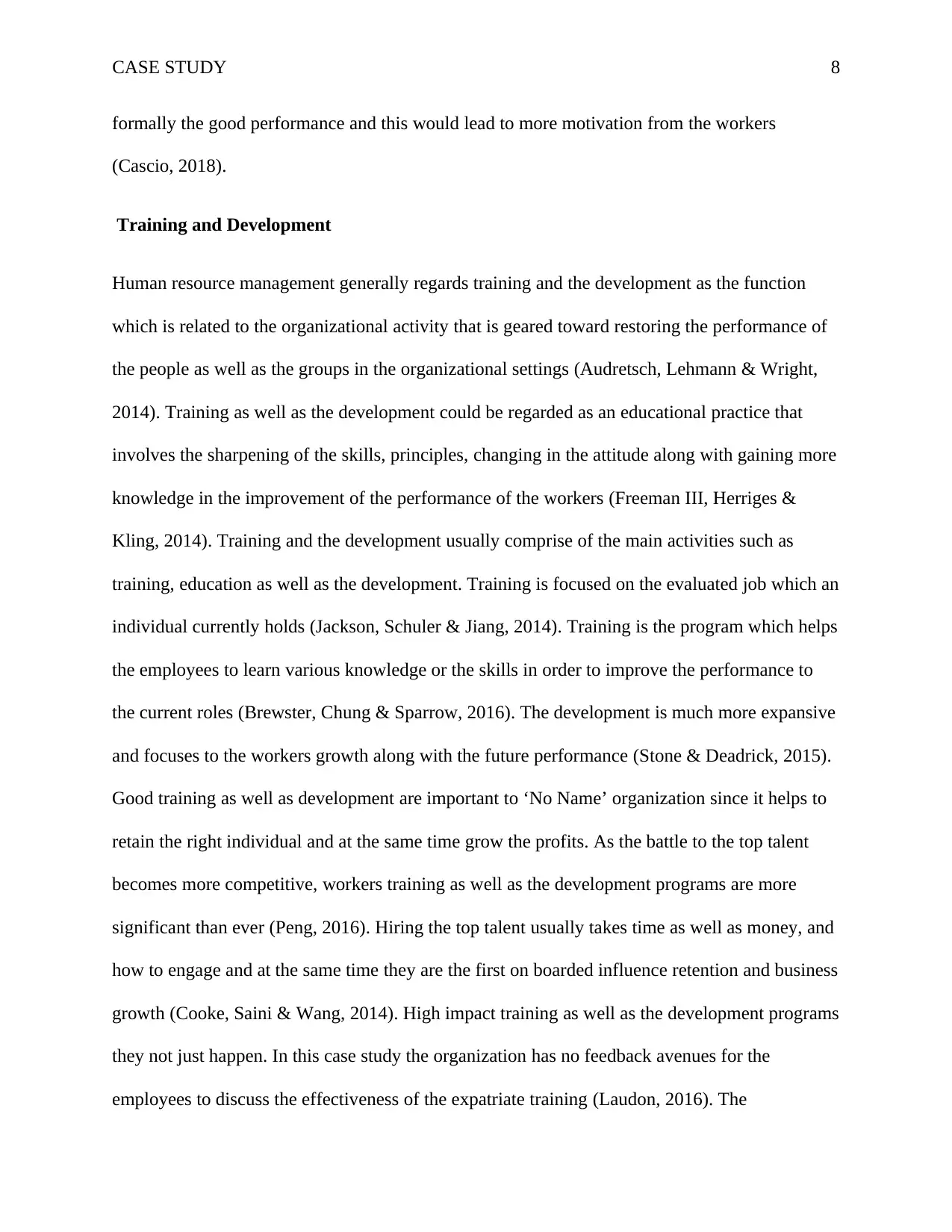
CASE STUDY 8
formally the good performance and this would lead to more motivation from the workers
(Cascio, 2018).
Training and Development
Human resource management generally regards training and the development as the function
which is related to the organizational activity that is geared toward restoring the performance of
the people as well as the groups in the organizational settings (Audretsch, Lehmann & Wright,
2014). Training as well as the development could be regarded as an educational practice that
involves the sharpening of the skills, principles, changing in the attitude along with gaining more
knowledge in the improvement of the performance of the workers (Freeman III, Herriges &
Kling, 2014). Training and the development usually comprise of the main activities such as
training, education as well as the development. Training is focused on the evaluated job which an
individual currently holds (Jackson, Schuler & Jiang, 2014). Training is the program which helps
the employees to learn various knowledge or the skills in order to improve the performance to
the current roles (Brewster, Chung & Sparrow, 2016). The development is much more expansive
and focuses to the workers growth along with the future performance (Stone & Deadrick, 2015).
Good training as well as development are important to ‘No Name’ organization since it helps to
retain the right individual and at the same time grow the profits. As the battle to the top talent
becomes more competitive, workers training as well as the development programs are more
significant than ever (Peng, 2016). Hiring the top talent usually takes time as well as money, and
how to engage and at the same time they are the first on boarded influence retention and business
growth (Cooke, Saini & Wang, 2014). High impact training as well as the development programs
they not just happen. In this case study the organization has no feedback avenues for the
employees to discuss the effectiveness of the expatriate training (Laudon, 2016). The
formally the good performance and this would lead to more motivation from the workers
(Cascio, 2018).
Training and Development
Human resource management generally regards training and the development as the function
which is related to the organizational activity that is geared toward restoring the performance of
the people as well as the groups in the organizational settings (Audretsch, Lehmann & Wright,
2014). Training as well as the development could be regarded as an educational practice that
involves the sharpening of the skills, principles, changing in the attitude along with gaining more
knowledge in the improvement of the performance of the workers (Freeman III, Herriges &
Kling, 2014). Training and the development usually comprise of the main activities such as
training, education as well as the development. Training is focused on the evaluated job which an
individual currently holds (Jackson, Schuler & Jiang, 2014). Training is the program which helps
the employees to learn various knowledge or the skills in order to improve the performance to
the current roles (Brewster, Chung & Sparrow, 2016). The development is much more expansive
and focuses to the workers growth along with the future performance (Stone & Deadrick, 2015).
Good training as well as development are important to ‘No Name’ organization since it helps to
retain the right individual and at the same time grow the profits. As the battle to the top talent
becomes more competitive, workers training as well as the development programs are more
significant than ever (Peng, 2016). Hiring the top talent usually takes time as well as money, and
how to engage and at the same time they are the first on boarded influence retention and business
growth (Cooke, Saini & Wang, 2014). High impact training as well as the development programs
they not just happen. In this case study the organization has no feedback avenues for the
employees to discuss the effectiveness of the expatriate training (Laudon, 2016). The
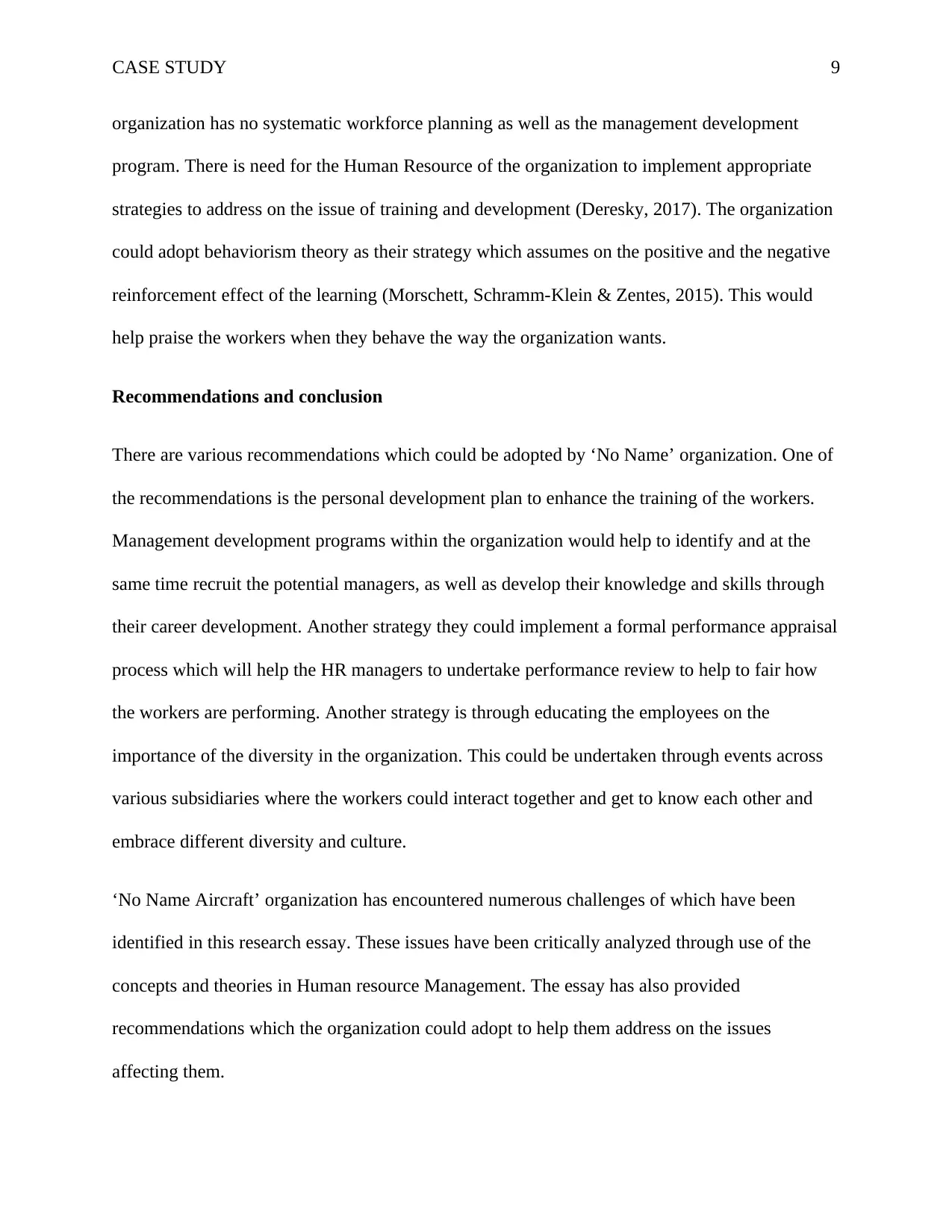
CASE STUDY 9
organization has no systematic workforce planning as well as the management development
program. There is need for the Human Resource of the organization to implement appropriate
strategies to address on the issue of training and development (Deresky, 2017). The organization
could adopt behaviorism theory as their strategy which assumes on the positive and the negative
reinforcement effect of the learning (Morschett, Schramm-Klein & Zentes, 2015). This would
help praise the workers when they behave the way the organization wants.
Recommendations and conclusion
There are various recommendations which could be adopted by ‘No Name’ organization. One of
the recommendations is the personal development plan to enhance the training of the workers.
Management development programs within the organization would help to identify and at the
same time recruit the potential managers, as well as develop their knowledge and skills through
their career development. Another strategy they could implement a formal performance appraisal
process which will help the HR managers to undertake performance review to help to fair how
the workers are performing. Another strategy is through educating the employees on the
importance of the diversity in the organization. This could be undertaken through events across
various subsidiaries where the workers could interact together and get to know each other and
embrace different diversity and culture.
‘No Name Aircraft’ organization has encountered numerous challenges of which have been
identified in this research essay. These issues have been critically analyzed through use of the
concepts and theories in Human resource Management. The essay has also provided
recommendations which the organization could adopt to help them address on the issues
affecting them.
organization has no systematic workforce planning as well as the management development
program. There is need for the Human Resource of the organization to implement appropriate
strategies to address on the issue of training and development (Deresky, 2017). The organization
could adopt behaviorism theory as their strategy which assumes on the positive and the negative
reinforcement effect of the learning (Morschett, Schramm-Klein & Zentes, 2015). This would
help praise the workers when they behave the way the organization wants.
Recommendations and conclusion
There are various recommendations which could be adopted by ‘No Name’ organization. One of
the recommendations is the personal development plan to enhance the training of the workers.
Management development programs within the organization would help to identify and at the
same time recruit the potential managers, as well as develop their knowledge and skills through
their career development. Another strategy they could implement a formal performance appraisal
process which will help the HR managers to undertake performance review to help to fair how
the workers are performing. Another strategy is through educating the employees on the
importance of the diversity in the organization. This could be undertaken through events across
various subsidiaries where the workers could interact together and get to know each other and
embrace different diversity and culture.
‘No Name Aircraft’ organization has encountered numerous challenges of which have been
identified in this research essay. These issues have been critically analyzed through use of the
concepts and theories in Human resource Management. The essay has also provided
recommendations which the organization could adopt to help them address on the issues
affecting them.
⊘ This is a preview!⊘
Do you want full access?
Subscribe today to unlock all pages.

Trusted by 1+ million students worldwide
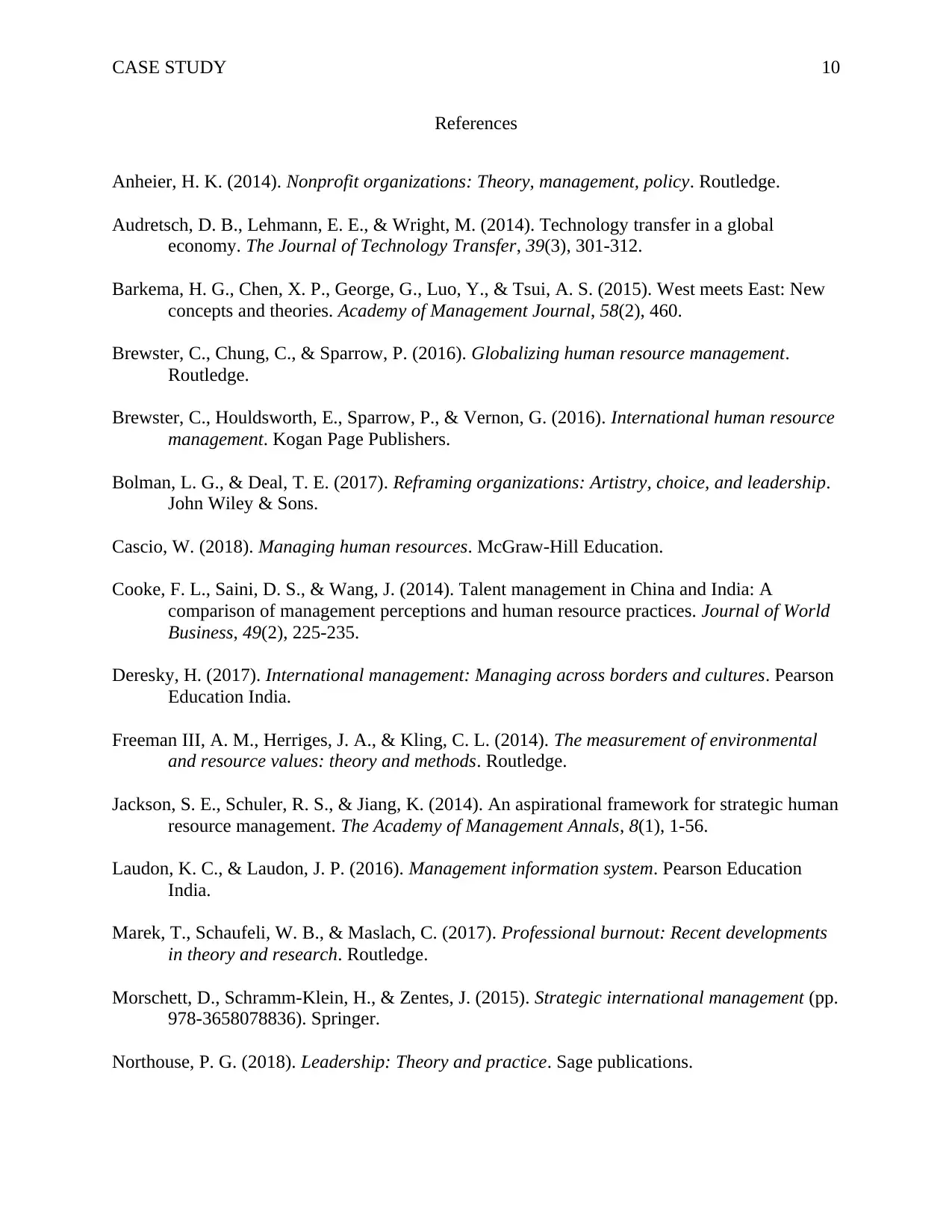
CASE STUDY 10
References
Anheier, H. K. (2014). Nonprofit organizations: Theory, management, policy. Routledge.
Audretsch, D. B., Lehmann, E. E., & Wright, M. (2014). Technology transfer in a global
economy. The Journal of Technology Transfer, 39(3), 301-312.
Barkema, H. G., Chen, X. P., George, G., Luo, Y., & Tsui, A. S. (2015). West meets East: New
concepts and theories. Academy of Management Journal, 58(2), 460.
Brewster, C., Chung, C., & Sparrow, P. (2016). Globalizing human resource management.
Routledge.
Brewster, C., Houldsworth, E., Sparrow, P., & Vernon, G. (2016). International human resource
management. Kogan Page Publishers.
Bolman, L. G., & Deal, T. E. (2017). Reframing organizations: Artistry, choice, and leadership.
John Wiley & Sons.
Cascio, W. (2018). Managing human resources. McGraw-Hill Education.
Cooke, F. L., Saini, D. S., & Wang, J. (2014). Talent management in China and India: A
comparison of management perceptions and human resource practices. Journal of World
Business, 49(2), 225-235.
Deresky, H. (2017). International management: Managing across borders and cultures. Pearson
Education India.
Freeman III, A. M., Herriges, J. A., & Kling, C. L. (2014). The measurement of environmental
and resource values: theory and methods. Routledge.
Jackson, S. E., Schuler, R. S., & Jiang, K. (2014). An aspirational framework for strategic human
resource management. The Academy of Management Annals, 8(1), 1-56.
Laudon, K. C., & Laudon, J. P. (2016). Management information system. Pearson Education
India.
Marek, T., Schaufeli, W. B., & Maslach, C. (2017). Professional burnout: Recent developments
in theory and research. Routledge.
Morschett, D., Schramm-Klein, H., & Zentes, J. (2015). Strategic international management (pp.
978-3658078836). Springer.
Northouse, P. G. (2018). Leadership: Theory and practice. Sage publications.
References
Anheier, H. K. (2014). Nonprofit organizations: Theory, management, policy. Routledge.
Audretsch, D. B., Lehmann, E. E., & Wright, M. (2014). Technology transfer in a global
economy. The Journal of Technology Transfer, 39(3), 301-312.
Barkema, H. G., Chen, X. P., George, G., Luo, Y., & Tsui, A. S. (2015). West meets East: New
concepts and theories. Academy of Management Journal, 58(2), 460.
Brewster, C., Chung, C., & Sparrow, P. (2016). Globalizing human resource management.
Routledge.
Brewster, C., Houldsworth, E., Sparrow, P., & Vernon, G. (2016). International human resource
management. Kogan Page Publishers.
Bolman, L. G., & Deal, T. E. (2017). Reframing organizations: Artistry, choice, and leadership.
John Wiley & Sons.
Cascio, W. (2018). Managing human resources. McGraw-Hill Education.
Cooke, F. L., Saini, D. S., & Wang, J. (2014). Talent management in China and India: A
comparison of management perceptions and human resource practices. Journal of World
Business, 49(2), 225-235.
Deresky, H. (2017). International management: Managing across borders and cultures. Pearson
Education India.
Freeman III, A. M., Herriges, J. A., & Kling, C. L. (2014). The measurement of environmental
and resource values: theory and methods. Routledge.
Jackson, S. E., Schuler, R. S., & Jiang, K. (2014). An aspirational framework for strategic human
resource management. The Academy of Management Annals, 8(1), 1-56.
Laudon, K. C., & Laudon, J. P. (2016). Management information system. Pearson Education
India.
Marek, T., Schaufeli, W. B., & Maslach, C. (2017). Professional burnout: Recent developments
in theory and research. Routledge.
Morschett, D., Schramm-Klein, H., & Zentes, J. (2015). Strategic international management (pp.
978-3658078836). Springer.
Northouse, P. G. (2018). Leadership: Theory and practice. Sage publications.
Paraphrase This Document
Need a fresh take? Get an instant paraphrase of this document with our AI Paraphraser
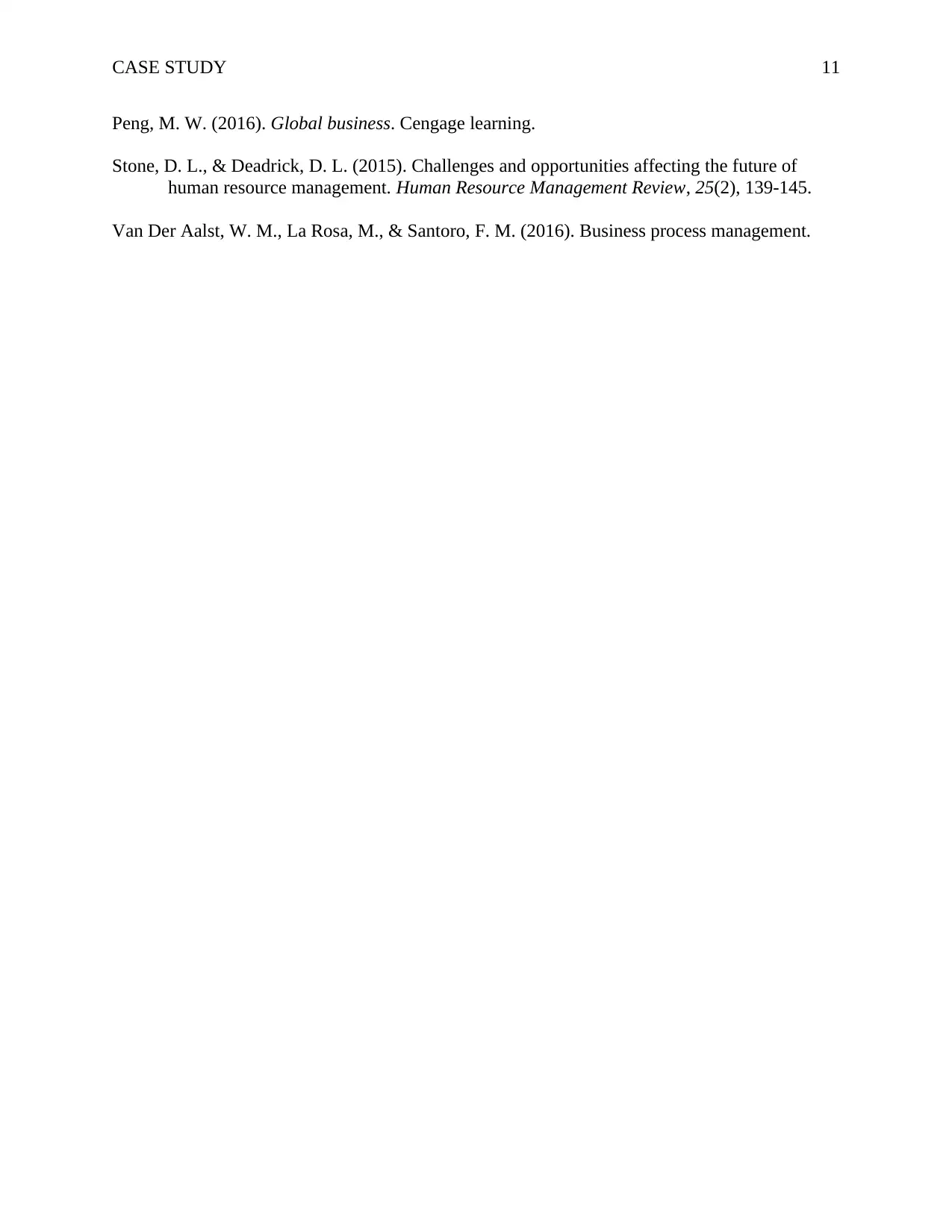
CASE STUDY 11
Peng, M. W. (2016). Global business. Cengage learning.
Stone, D. L., & Deadrick, D. L. (2015). Challenges and opportunities affecting the future of
human resource management. Human Resource Management Review, 25(2), 139-145.
Van Der Aalst, W. M., La Rosa, M., & Santoro, F. M. (2016). Business process management.
Peng, M. W. (2016). Global business. Cengage learning.
Stone, D. L., & Deadrick, D. L. (2015). Challenges and opportunities affecting the future of
human resource management. Human Resource Management Review, 25(2), 139-145.
Van Der Aalst, W. M., La Rosa, M., & Santoro, F. M. (2016). Business process management.
1 out of 11
Related Documents
Your All-in-One AI-Powered Toolkit for Academic Success.
+13062052269
info@desklib.com
Available 24*7 on WhatsApp / Email
![[object Object]](/_next/static/media/star-bottom.7253800d.svg)
Unlock your academic potential
Copyright © 2020–2025 A2Z Services. All Rights Reserved. Developed and managed by ZUCOL.




